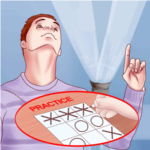|
Thanks for making this, it was very interesting to watch. Having watched the no-sound videos only, my interpretation is that Coda is a character, rather than a person. And so the character Coda makes the games that the Narrator does not dare to make? They are all dark in a sense, with themes of impossibility and insufficiency. Is the Narrator using Coda to explore this themes without having to face them personally? And is the Beginners Guide game, then, Wreden owning up to the Coda part of his personality, taking you for a walk in his subconscious, so to speak? EDIT: After seeing the narrated part of the LP, I think the argument for Coda being a character is somewhat weaker, since he is portrayed as having more agency in the narration. On the other hand it allows for the possibility of Coda being the woman - since he is a character of Wreden, he can take on female aspects as needed. "Coda" (short for "coder") is also the sort of pseudonym a teenaged would-be game maker could adopt. Perhaps this is where the reference to meeting Coda at a game jam comes from. Morholt fucked around with this message at 22:48 on Oct 30, 2015 |
|
|
|

|
| # ? Apr 27, 2024 00:31 |
|
I just realised that the Final Prison Escape game is The Beginner's Guide in a whole. It is Davey after sorting through his issues (Coda) talking to Davey in the past. (Narrator Davey) There is no solution that Coda's games because he can't give him one - he has to get himself out of it and the talk in the Epilogue represents it - especially when Narrator Davey leaves to sort himself out.
|
|
|
|
Late to the party on this but watching through these now and this is an awesome concept, and probably the perfect way to LP this game. I do really enjoy watching people react to this game though - [url=https://www.youtube.com/watch?v=xQVNcaXWGdA[/url]Voidburger[/url] and Psychedelic Eyeball both streamed it and had surprisingly different (though both interesting) reactions. Of course, by analysing people's analysis of the game about over-analysis I am now rapidly disappearing past the event horizon of my own rear end. One thing I noticed that I never saw before: the dressing room at the start of the Theatre level is very similar to the prison games. I think I agree with Mr Phillby's reading. There's also a really well written blog post by Wreden where he talks about his extreme discomfort with hearing people analyse his game that provides some context for this. Edit - I just remembered something. The date of Tower (June 2011) is the month before the Stanley Parable was released. Kloro fucked around with this message at 20:27 on Oct 31, 2015 |
|
|
|
There is this one other postmodernist work that I refer to this game in context with. It's a graphic novel by a Canadian author named Seth called It's a Good Life, If You Don't Weaken. Like this game, it was Seth's second major work following a successful (for Canada) first book called Palookaville. It's a Goodlife has a main character of its own author as a self-insert, and the (explicit, but not implicit) plot involves him trying to find and visit another graphic novelist called Kalo, who was published in the New Yorker some several decades earlier. (In reality, it was never about Kalo; it was all about Seth from the very beginning.) Both this game and that book were also responses to a sophomore slump of sorts, and ruminated on the nature of their respective mediums -- in Seth's case, comics as opposed to games. I'll be honest in saying that while I read it, I thought Seth's book was terrible. I could read it, and while I definitely saw it was very symbolic and insightful to Seth, I felt nothing for it. I only could eventually piece together what any of it could've possibly meant from a literary analysis provided by a university professor sometime later on. I can completely understand why it might have been written, as a kind of forced response to creative block -- the diarrhoea of the artistic process. I know I am guilty of the same style of work myself from my own darker moments, but what I found curious is why Seth took the unusual step of publishing his own. See the numerous historical cases of writers asking their unpublished things be burned after their death, only for that request to be ignored. That's probably relevant here, vis-a-vis what Coda was making his own games for. At least this game manages what Seth couldn't in actually having some element of emotional punch for other people to follow along with; what It's a Good Life really needed was Kalo to rise out of the grave and tell Seth to the hell screw off. That's an improvement, as far I am concerned. As far as I can tell, only the first two or three lightposts in Coda's games were genuine -- or maybe just the first one. You see later on as the anthology progresses, that the lightposts seem almost haphazardly added to a scene that would regain its symmetry or composition if removed, like in the housecleaning and lecture games where the lightpost just doesn't add anything -- or on the stage or the trapped muse where the lightpost is just sort of there for no reason. We only don't notice it because the first few games that contain lightposts have it where the lightpost "fits in" with the composition of the level: next to the phone booth, for example, looks just natural enough. Even when the typewriter room is revisited in Coda's 2nd last game, the lightpost there is absent, despite how well-placed it actually was in the original.
|
|
|
|
I didn't realize it until you had that little discussion on the tarot cards, but chapter The Tower game happens in is called "Chapter 16: The Tower". In it, the reveal of what's been going on in the story happens and Davey has his breakdown. As you said, The Tower is all about faulty assumptions and facades crashing down to reveal the ugly truth and leave seemingly ruin and devastation in the immediate aftermath. But after that is the Epilogue (which had it a number, would be number 17), where Davey begins to finally show signs of true realization on his part as he leaves the player: there is Hope that he can recover and truly begin to become a better person after this ordeal. Exactly what the Star symbolizes. There might be other mappings of the chapters to corresponding tarot cards I'm not aware of, for example the game starts with chapter 0, to introduces us to The Fool (whether that's Davey or Coda is another discussion entirely). The game after that is a seemingly standard FPS level that ends with a moment of unexpected enlightenment about what the tools one has at their disposal (the Source engine in this case) can possibly allow them to do in the future. The Magician, in other words. The game after that is about a woman seeking wisdom to confront the challenges ahead of her. The Priestess. ...of course, down that path lies the possibility of falling into Davey's trap, so perhaps I should stop here.
|
|
|
|

|
| # ? Apr 27, 2024 00:31 |
|
It's funny seeing a lot of responses and analysis here calling either of the characters a bad person or playing armchair psychologist when as FicusArt mentioned earlier the game's message seems to be that doing just that is dangerous and easy to get wrong while convincing yourself you are totally in the right. Not to say that all analysis is evil and bad but the idea that we can get a full view of the characters and declare them good or bad or broken or depressed or insecure based on how they make/edit their games is the exact same mistake Davey (character) falls into. I definitely remember going through a lot of my own thoughts about what was "wrong" with Coda while playing the game and then that gut punch happens and turning very sharply on Davey. But thinking back on it there's really more to both characters, they both have problems and both of them were probably trying to do the right thing. Even as I write this I'm imparting my personal feelings on the characters, but I think that helps indicate there might not be a "true" interpretation of what is supposed to have happened. I do believe that immediately applying the concept of intentional malice or ill-will to either of the characters (like Davey is stealing the levels or deliberately mislabeling Coda's gender) to be rather black and white in what I see as a shades of gray kind of story. But with all that said it's kind of impossible not to have an interpretation and opinion of this game. In that sense we're all adding our own lampposts to someone's creation.
|
|
|







